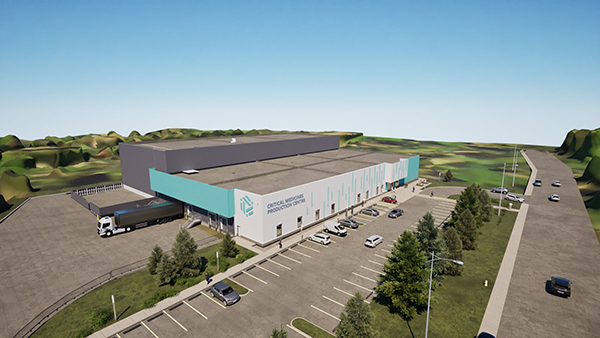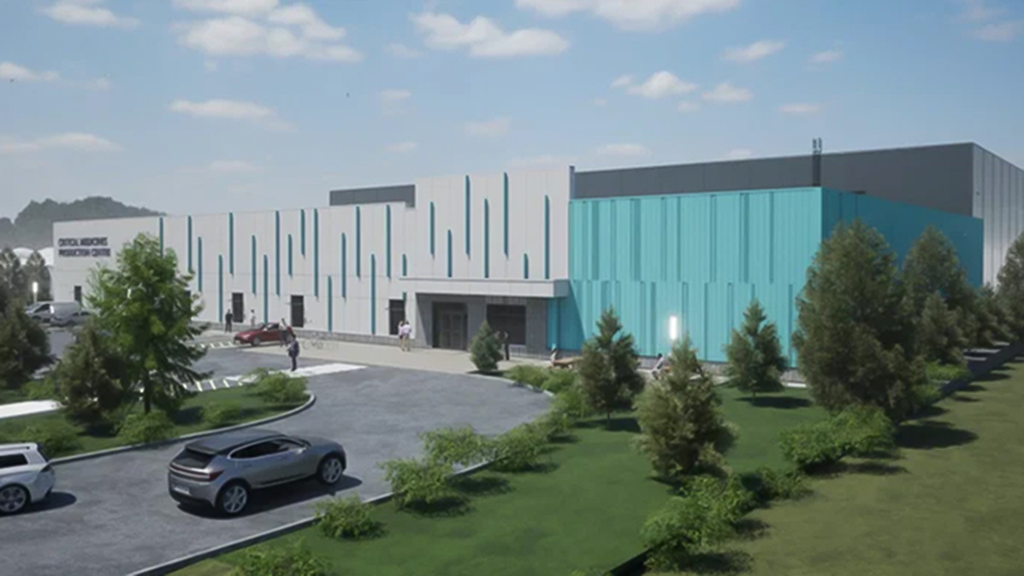Construction crews have erected the exterior superstructure of a massive Critical Medicines Production Centre (CMPC) on a seven-acre plot of land in the Edmonton Research Park that will position the city as a leading hub for life sciences in Canada.
The building will be a cornerstone of the $200-million Canadian Critical Drug Initiative (CCDI), a strategy devised in the wake of COVID-19 to strengthen the nation’s biomanufacturing and pharmaceutical supply chain.
Upon completion, the 83,000-square-foot structure will be Canada’s largest manufacturing facility for critical medicines. START Architecture Inc. and CRB Consulting Engineers are involved in development of the facility.
“As of March 2025, the building shell is nearly finished, with equipment installation set to begin mid-year,” explains Jenna Bienert, associate director, brand marketing at Applied Pharmaceutical Innovation (API), which is collaborating on the project with the Li Ka Shing Applied Virology Institute at the University of Alberta.
“We anticipate major equipment installation to be largely completed by the end of 2025, with full operations commencing in 2026 following facility and equipment validation and regulatory approvals.”

The structure is the culmination of four years of design and specification work.
“Through the CCDI, we’re developing a Life Sciences Campus within the Edmonton Research Park – anchored by the CMPC – to expand shared manufacturing capacity, accelerate innovation, and position Edmonton as a leading hub for life sciences in Canada,” says Bienert. “Beyond addressing critical supply needs, the facility creates new opportunities for end-to-end drug development, allowing API to offer full support from phase one to three clinical trials through to commercial-scale manufacturing.”
The new centre will also provide essential infrastructure for researchers and companies to bring novel therapies to market and serve as a hub for training and talent development.
The CMPC will be a game-changer for the Prairies as it will drive research and development of medications and critical medicines. The facility will be able to produce more than 70 million doses of product a year.
The centre will produce small-molecule active pharmaceutical ingredients and conduct sterile, aseptic fill, and finish of traditional and biologic drugs in capacity ranges required to meet drug shortages and pandemic needs.
More specifically, the CMPC will be a GMP-certified facility for phase three and commercial-scale manufacturing. This will enable innovations from researchers across Alberta and Canada, resulting in the development of life-saving drugs, and mitigating the current challenge of innovative companies having to look beyond Canada’s borders at the time they are beginning to truly scale.

“It will provide the infrastructure, capacity and resources needed to support innovators across the full development cycle – from early-stage research through all phases of clinical trials to commercial manufacturing,” says Bienert.
Other benefits include improved patient access to needed medicines, enhanced hospital operations and the addition of much-needed capacity to produce and manufacture therapeutic drugs in Canada.
The structure itself has been designed with advanced infrastructure to support end-to-end pharmaceutical manufacturing and promote production efficiency while also being able to deliver a single product to the entire Canadian population within 100 days during a public health crisis.
One of the first products of the facility will be Propofol, a critical hospital drug.
The facility will have truck bays, offices, labs and a fully automated, robotic line with an isolator to ensure low reject rates and minimal time losses as well as the ability to fill vials and bottles of various sizes.
The equipment will provide 100 per cent visual inspection and container closure integrity, sterilization systems for safe production and a packaging line equipped with various carton sizes and eco-trays for sustainable packaging.
An onsite microbiology lab will support sterile production while warehouses on the premises will include cold storage and freezer capacity to support pharmaceutical storage requirements.
API chief executive officer Andrew MacIsaac says the production centre and broader CCDI are tremendous steps forwards towards making Alberta a leader in manufacturing critical medicines.
“This initiative will create potentially thousands of jobs in the life sciences sector, delivering substantial benefits to Canada’s life sciences ecosystem by attracting investment, fostering job creation, and retaining intellectual property and talent within the country. More importantly, it will provide access to life saving treatments when we need them most.”
Michal Houghton, director of the Li Ka Shing Applied Virology Institute and chief scientific officer at API, says the centre will expand the life sciences industry and fortify Canada’s readiness against pandemics.
“Additionally, it will drive the research and development of medications targeting prevalent diseases lacking preventive measures. Through these efforts, we aim to safeguard and enhance lives globally.”
The CMPC will work in conjunction with the 72,000-square-foot Biotechnology Business Development Centre, which is being upgraded.




Recent Comments